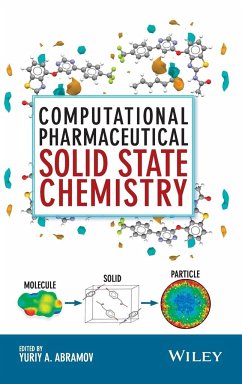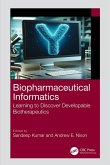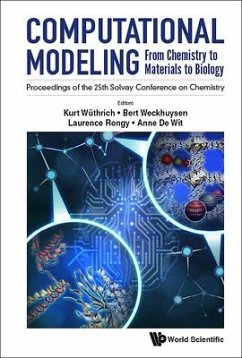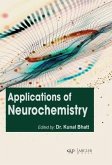Computational Pharmaceutical Solid State Chemistry
Herausgeber: Abramov, Yuriy A
Computational Pharmaceutical Solid State Chemistry
Herausgeber: Abramov, Yuriy A
- Gebundenes Buch
- Merkliste
- Auf die Merkliste
- Bewerten Bewerten
- Teilen
- Produkt teilen
- Produkterinnerung
- Produkterinnerung
This book is the first to combine computational material science and modeling of molecular solid states for pharmaceutical industry applications. * Provides descriptive and applied state-of-the-art computational approaches and workflows to guide pharmaceutical solid state chemistry experiments and to support/troubleshoot API solid state selection * Includes real industrial case examples related to application of modeling methods in problem solving * Useful as a supplementary reference/text for undergraduate, graduate and postgraduate students in computational chemistry, pharmaceutical and biotech sciences, and materials science…mehr
Andere Kunden interessierten sich auch für
![Biopharmaceutical Informatics Biopharmaceutical Informatics]() Biopharmaceutical Informatics143,99 €
Biopharmaceutical Informatics143,99 €![Computational Modeling: From Chemistry to Materials to Biology - Proceedings of the 25th Solvay Conference on Chemistry Computational Modeling: From Chemistry to Materials to Biology - Proceedings of the 25th Solvay Conference on Chemistry]() Computational Modeling: From Chemistry to Materials to Biology - Proceedings of the 25th Solvay Conference on Chemistry165,99 €
Computational Modeling: From Chemistry to Materials to Biology - Proceedings of the 25th Solvay Conference on Chemistry165,99 €![Computational Techniques for Analytical Chemistry and Bioanalysis Computational Techniques for Analytical Chemistry and Bioanalysis]() Computational Techniques for Analytical Chemistry and Bioanalysis244,99 €
Computational Techniques for Analytical Chemistry and Bioanalysis244,99 €![Computational Catalysis Computational Catalysis]() Computational Catalysis293,99 €
Computational Catalysis293,99 €![Attosecond Molecular Dynamics Attosecond Molecular Dynamics]() Attosecond Molecular Dynamics258,99 €
Attosecond Molecular Dynamics258,99 €![Applications of Neurochemistry Applications of Neurochemistry]() Applications of Neurochemistry207,99 €
Applications of Neurochemistry207,99 €![Biologically Active Natural Products Biologically Active Natural Products]() Stephen J. Cutler (ed.)Biologically Active Natural Products305,99 €
Stephen J. Cutler (ed.)Biologically Active Natural Products305,99 €-
-
-
This book is the first to combine computational material science and modeling of molecular solid states for pharmaceutical industry applications. * Provides descriptive and applied state-of-the-art computational approaches and workflows to guide pharmaceutical solid state chemistry experiments and to support/troubleshoot API solid state selection * Includes real industrial case examples related to application of modeling methods in problem solving * Useful as a supplementary reference/text for undergraduate, graduate and postgraduate students in computational chemistry, pharmaceutical and biotech sciences, and materials science
Hinweis: Dieser Artikel kann nur an eine deutsche Lieferadresse ausgeliefert werden.
Hinweis: Dieser Artikel kann nur an eine deutsche Lieferadresse ausgeliefert werden.
Produktdetails
- Produktdetails
- Verlag: John Wiley & Sons / Wiley
- Seitenzahl: 448
- Erscheinungstermin: 18. April 2016
- Englisch
- Abmessung: 240mm x 161mm x 28mm
- Gewicht: 821g
- ISBN-13: 9781118700747
- ISBN-10: 1118700740
- Artikelnr.: 41755164
- Herstellerkennzeichnung
- Libri GmbH
- Europaallee 1
- 36244 Bad Hersfeld
- gpsr@libri.de
- Verlag: John Wiley & Sons / Wiley
- Seitenzahl: 448
- Erscheinungstermin: 18. April 2016
- Englisch
- Abmessung: 240mm x 161mm x 28mm
- Gewicht: 821g
- ISBN-13: 9781118700747
- ISBN-10: 1118700740
- Artikelnr.: 41755164
- Herstellerkennzeichnung
- Libri GmbH
- Europaallee 1
- 36244 Bad Hersfeld
- gpsr@libri.de
Yuriy A. Abramov, PhD, is a Senior Principal Scientist with over 14 years of experience in computational sciences in drug discovery and development with Pfizer, Inc., in Groton, CT, USA. He holds a PhD in Physical Chemistry from the D. Mendeleev University of Chemical Technology of Russia and Karpov Institute of Physical Chemistry in Moscow.
List of Contributors xiii Preface xvii Editor's biography xix 1 Computational Pharmaceutical Solid
State Chemistry: An Introduction 1 Yuriy A. Abramov 1.1 Introduction 1 1.2 Pharmaceutical Solid
State Landscape 2 1.2.1 Some Definitions 2 1.2.2 Impact of Solid
State Form on API and Product Properties 4 1.2.3 Challenges of Pharmaceutical Industry Related to Solid Form Selection 6 1.3 Pharmaceutical Computational Solid
State Chemistry 8 1.4 Conclusions 9 Acknowledgment 10 References 10 2 Navigating the Solid Form Landscape with Structural Informatics 15 Peter T. A. Galek, Elna Pidcock, Peter A. Wood, Neil Feeder, and Frank H. Allen 2.1 Introduction 15 2.2 The CSD System 17 2.3 Hydrogen
Bond Propensity: Theory and Applications to Polymorphism 18 2.3.1 Methodology 18 2.3.2 Case Study 1: Ritonavir 19 2.4 Hydrogen
Bond Landscapes: Developing the Propensity Approach 21 2.4.1 Methodology 21 2.4.2 Case Study 2: Metastable versus Stable Form of Piroxicam 22 2.4.3 Case Study 3: Exploring the Likely Hydrogen
Bond Landscape of Axitinib (Inlyta®) 25 2.5 Informatics
Based Cocrystal Screening 25 2.5.1 Methodology 25 2.5.2 Case Study 4: Paracetamol 26 2.5.3 Case Study 5: AMG 517 - Sorbic Acid Cocrystal 29 2.6 Conclusions and Outlook 32 References 33 3 Theoretical Hydrogen
Bonding Analysis for Assessment of Physical Stability of Pharmaceutical Solid Forms 37 Yuriy A. Abramov 3.1 Introduction 37 3.2 Experimental Scales of H
Bonding Basicity and Acidity 39 3.2.1 In Solution Phase 39 3.2.2 In Solid
State Phase 40 3.3 Theoretical Study of H
Bonding Strength in Solution and in Solid State 40 3.3.1 Supermolecular Approach 41 3.3.2 Descriptor
Based Approaches 41 3.3.3 Solid
State H
bonding Strength 42 3.4 Application to Solid Form Selection 47 3.4.1 Examples of Theoretical H
Bonding Analysis to Support Solid Form Selection 48 3.4.2 Consideration of Limitations of Hydrogen
Bonding Propensity Approach 50 3.5 Conclusion 52 Acknowledgment 53 References 53 4 Improving Force Field Parameters for Small
Molecule Conformation Generation 57 Dmitry Lupyan, Yuriy A. Abramov, and Woody Sherman 4.1 Introduction 57 4.2 Methods 62 4.3 Results and Discussion 66 4.3.1 Close S
O Interactions 66 4.3.2 Halogen X
O Interactions 75 4.3.3 Generalization of the Approach to Other Interactions 77 4.3.4 An Improved OPLS Force Field (OPLS2) 80 4.4 Conclusion 81 References 82 5 Advances in Crystal Structure Prediction and Applications to Pharmaceutical Materials 87 Graeme M. Day 5.1 Introduction 87 5.1.1 Motivation 88 5.2 Crystal Structure Prediction Methodologies 89 5.2.1 Molecular Geometry 89 5.2.2 Crystal Structure Searching 99 5.2.3 Structure Ranking 102 5.3 Applications of Crystal Structure Prediction 105 5.3.1 Crystal Structure Determination 106 5.3.2 Solid Form Screening 108 5.4 Summary 110 References 110 6 Integrating Computational Materials Science Tools in Form and Formulation Design 117 Joseph F. Krzyzaniak, Paul A. Meenan, Cheryl L. Doherty, Klimentina Pencheva, Suman Luthra, and Aurora Cruz
Cabeza 6.1 Introduction 117 6.2 From Molecule to Crystal Structure 119 6.2.1 Single Crystal Structure 120 6.2.2 Structural Analysis 120 6.2.3 Molecular Packing and HB Geometry Analyses 122 6.2.4 Full Interaction Maps 123 6.2.5 Crystal Structure Prediction 124 6.3 From Crystals to Particles 131 6.4 From Particles to Dosage Forms 134 6.4.1 Structural Investigation of Crystal Surfaces and Structure Dehydration 137 6.4.2 Structural Investigations of Crystal Surfaces and Chemical Stability 139 6.5 Conclusion 141 Acknowledgments 142 References 142 7 Current Computational Approaches at Astrazeneca for Solid
State and Property Predictions 145 Sten O. Nilsson Lill, Staffan Schantz, Viktor Broo, and Anders Broo 7.1 Introduction 145 7.2 Polymorphism 146 7.3 Conformer Search 157 7.4 Molecular Perturbations to Achieve Solubility for GPR119 Ligands 158 7.5 Solid
State Nuclear Magnetic Resonance and Azd8329 Case Study 163 7.6 CCDC Tools 168 7.7 Tautomerism 169 7.8 Conclusions 170 Acknowledgments 170 References 170 8 Synthonic Engineering: From Molecular and Crystallographic Structure to the Rational Design of Pharmaceutical Solid Dosage Forms 175 Kevin J. Roberts, Robert B. Hammond, Vasuki Ramachandran, and Robert Docherty 8.1 Introduction 175 8.2 The Crystal 177 8.2.1 Crystallography 177 8.2.2 Crystal Chemistry and Crystal Packing of Drug Molecules 179 8.2.3 Deconstructing the SupräMolecular Interactions in Bulk - Intrinsic Synthons 181 8.3 Morphology and Surface Structure 185 8.3.1 Nucleation and the Crystal Growth Process 185 8.3.2 Particle Morphology and Surface Structure 186 8.3.3 Crystal Morphology Prediction 188 8.3.4 Deconstructing the SupräMolecular Interactions at Surfaces - Extrinsic Synthons 190 8.3.5 Grid Searching - Probing Inter
molecular Interactions at Surfaces and Environments 190 8.4 The Crystallisation Perspective 191 8.4.1 Nucleation, Surface Energies and Directed Polymorphism 191 8.4.2 The Impact of Solvent on Morphology 194 8.4.3 The Impact of Impurities on Morphology 196 8.5 The Drug Product Perspective 197 8.5.1 Excipient Compatibility 197 8.5.2 Inhaled Drug Delivery Design 199 8.5.3 Mechanical Properties 201 8.5.4 Dissolution 203 8.6 Summary and Future Outlook: Synthonic Engineering Particle Passport and the Future of the Drug Product Design 205 Acknowledgements 207 References 207 9 New Developments in Prediction of Solid
State Solubility and Cocrystallization Using COSMO
RS Theory 211 Christoph Loschen and Andreas Klamt 9.1 Introduction 211 9.2 COSMO
RS 212 9.3 Prediction of Drug Solubility Using COSMO
RS 215 9.4 Solubility Prediction with Multiple Reference Solvents 218 9.5 Melting Point and Fusion Enthalpy QSPR Models 221 9.6 Cocrystal Screening 225 9.7 Solvate Formation 229 9.8 Summary 231 References 231 10 Modeling and Prediction of Solid Solubility by Ge Models 235 Larissa P. Cunico, Anjan K. Tula, Roberta Ceriani, and Rafiqul Gani 10.1 Introduction 235 10.2 Framework 236 10.2.1 Thermodynamic Basis 238 10.2.2 The Necessary Property
Related Information for Solid Solubility Prediction and the Developed Databases 238 10.2.3 SLE Thermodynamic Consistency Tests 241 10.2.4 SolventPro 252 10.3 Conclusion 259 References 260 11 Molecular Simulation Methods to Compute Intrinsic Aqueous Solubility of Crystalline Drug
Like Molecules 263 David S. Palmer and Maxim V. Fedorov 11.1 Introduction 263 11.2 Definitions of Solubility 264 11.3 Solubility and Thermodynamics 264 11.3.1 Solubility and Free Energy of Solution 264 11.3.2 Computation of Solubility from the Thermodynamic Cycle of Solid to Supercooled Liquid to Aqueous Solution 265 11.3.3 Computation of Solubility from the Thermodynamic Cycle of Solid to Gas Phase to Aqueous Solution 267 11.4 Calculation of
Ghyd 269 11.4.1 Implicit Continuum Solvent Models 270 11.4.2 Explicit Solvent Models: Atomistic Simulations 270 11.4.3 Explicit Solvent Models: Molecular Theories of Liquids 271 11.5 Calculation of
Gsub 275 11.5.1 Crystal Polymorphism 275 11.5.2 Crystal Structure Prediction 275 11.5.3 Calculation of
Gsub 276 11.5.4 Calculation of
Hsub 276 11.5.5 Calculation of
Ssub 277 11.5.6 Other Methods to Compute
Gsub 278 11.6 Experimental Data 279 11.7 Conclusion and Future Outlook 280 Acknowledgments 280 References 280 12 Calculation of NMR Tensors: Application to Small
Molecule Pharmaceutical Solids 287 Luis Mafra, Sergio Santos, Mariana Sardo, and Heather Frericks Schmidt 12.1 SSNMR Spectroscopy: A Short Introduction 287 12.2 The Chemical Shielding Tensors: Fundamentals 288 12.3 Computational Approaches to the Calculation of Chemical Shift Tensors in Solids 290 12.3.1 Cluster Approach 290 12.3.2 Periodic Approach 291 12.3.3 Pitfalls and Practical Considerations 292 12.4 NICS 294 12.5 Case Studies Combining Experimental and Computational NMR Methods 294 12.5.1 NMR Assignment of Polymorphs Aided by Computing NMR Parameters 295 12.5.2 Calculated vs Experimental Chemical Shift Tensors Using Different NMR Methods 302 12.5.3 Studying Crystal Packing Interactions 312 12.5.4 Employing Chemical Shifts for Crystal Structure Elucidation/Determination 315 12.6 Summary 325 References 326 13 Molecular Dynamics Simulations of Amorphous Systems 331 Bradley D. Anderson and Tian
Xiang Xiang 13.1 Introduction 331 13.2 MD Simulation Methodology 332 13.3 Polymer Properties-MD Simulation Versus Experiment 334 13.3.1 Glass Transition Temperature (Tg) 334 13.3.2 Amorphous Structure and Dynamics 337 13.4 Hydrogen Bonding Patterns, Water Uptake, and Distribution in Amorphous Solids 342 13.4.1 Poly(D,L)lactide 343 13.4.2 Polyvinylpyrrolidone 345 13.4.3 Hydroxypropylmethylcellulose Acetate Succinate (HPMCAS) 347 13.4.4 Amorphous Indomethacin 350 13.5 Amorphous Drug-Polymer Blends 354 13.5.1 Molecular Interactions Probed by MD Simulation 354 13.5.2 Solubility and Miscibility Prediction 357 13.5.3 Molecular Mobility and Small
Molecule Diffusion in Amorphous Dispersions 361 13.5.4 Plasticization by Water Clusters 365 13.6 Summary 367 References 368 14 Numerical Simulations of Unit Operations in Pharmaceutical Solid Dose Manufacturing 375 Ekneet Kaur Sahni, Shivangi Naik, and Bodhisattwa Chaudhuri 14.1 Introduction 375 14.2 Numerical Method 376 14.2.1 Contact Drying in an Agitated Filter Dryer 376 14.2.2 Coating in a Conventional Pan Coater 378 14.2.3 Modeling of milling in a Wiley Mill 379 14.3 Experimental Method for Milling 380 14.4 Results and Discussion 380 14.4.1 Simulation of Contact Drying 380 14.4.2 Simulation of Tablet Coating 384 14.4.3 Simulation of Size Fragmentation (Milling) 387 14.5 Summary and Conclusions 391 References 392 Index 395
State Chemistry: An Introduction 1 Yuriy A. Abramov 1.1 Introduction 1 1.2 Pharmaceutical Solid
State Landscape 2 1.2.1 Some Definitions 2 1.2.2 Impact of Solid
State Form on API and Product Properties 4 1.2.3 Challenges of Pharmaceutical Industry Related to Solid Form Selection 6 1.3 Pharmaceutical Computational Solid
State Chemistry 8 1.4 Conclusions 9 Acknowledgment 10 References 10 2 Navigating the Solid Form Landscape with Structural Informatics 15 Peter T. A. Galek, Elna Pidcock, Peter A. Wood, Neil Feeder, and Frank H. Allen 2.1 Introduction 15 2.2 The CSD System 17 2.3 Hydrogen
Bond Propensity: Theory and Applications to Polymorphism 18 2.3.1 Methodology 18 2.3.2 Case Study 1: Ritonavir 19 2.4 Hydrogen
Bond Landscapes: Developing the Propensity Approach 21 2.4.1 Methodology 21 2.4.2 Case Study 2: Metastable versus Stable Form of Piroxicam 22 2.4.3 Case Study 3: Exploring the Likely Hydrogen
Bond Landscape of Axitinib (Inlyta®) 25 2.5 Informatics
Based Cocrystal Screening 25 2.5.1 Methodology 25 2.5.2 Case Study 4: Paracetamol 26 2.5.3 Case Study 5: AMG 517 - Sorbic Acid Cocrystal 29 2.6 Conclusions and Outlook 32 References 33 3 Theoretical Hydrogen
Bonding Analysis for Assessment of Physical Stability of Pharmaceutical Solid Forms 37 Yuriy A. Abramov 3.1 Introduction 37 3.2 Experimental Scales of H
Bonding Basicity and Acidity 39 3.2.1 In Solution Phase 39 3.2.2 In Solid
State Phase 40 3.3 Theoretical Study of H
Bonding Strength in Solution and in Solid State 40 3.3.1 Supermolecular Approach 41 3.3.2 Descriptor
Based Approaches 41 3.3.3 Solid
State H
bonding Strength 42 3.4 Application to Solid Form Selection 47 3.4.1 Examples of Theoretical H
Bonding Analysis to Support Solid Form Selection 48 3.4.2 Consideration of Limitations of Hydrogen
Bonding Propensity Approach 50 3.5 Conclusion 52 Acknowledgment 53 References 53 4 Improving Force Field Parameters for Small
Molecule Conformation Generation 57 Dmitry Lupyan, Yuriy A. Abramov, and Woody Sherman 4.1 Introduction 57 4.2 Methods 62 4.3 Results and Discussion 66 4.3.1 Close S
O Interactions 66 4.3.2 Halogen X
O Interactions 75 4.3.3 Generalization of the Approach to Other Interactions 77 4.3.4 An Improved OPLS Force Field (OPLS2) 80 4.4 Conclusion 81 References 82 5 Advances in Crystal Structure Prediction and Applications to Pharmaceutical Materials 87 Graeme M. Day 5.1 Introduction 87 5.1.1 Motivation 88 5.2 Crystal Structure Prediction Methodologies 89 5.2.1 Molecular Geometry 89 5.2.2 Crystal Structure Searching 99 5.2.3 Structure Ranking 102 5.3 Applications of Crystal Structure Prediction 105 5.3.1 Crystal Structure Determination 106 5.3.2 Solid Form Screening 108 5.4 Summary 110 References 110 6 Integrating Computational Materials Science Tools in Form and Formulation Design 117 Joseph F. Krzyzaniak, Paul A. Meenan, Cheryl L. Doherty, Klimentina Pencheva, Suman Luthra, and Aurora Cruz
Cabeza 6.1 Introduction 117 6.2 From Molecule to Crystal Structure 119 6.2.1 Single Crystal Structure 120 6.2.2 Structural Analysis 120 6.2.3 Molecular Packing and HB Geometry Analyses 122 6.2.4 Full Interaction Maps 123 6.2.5 Crystal Structure Prediction 124 6.3 From Crystals to Particles 131 6.4 From Particles to Dosage Forms 134 6.4.1 Structural Investigation of Crystal Surfaces and Structure Dehydration 137 6.4.2 Structural Investigations of Crystal Surfaces and Chemical Stability 139 6.5 Conclusion 141 Acknowledgments 142 References 142 7 Current Computational Approaches at Astrazeneca for Solid
State and Property Predictions 145 Sten O. Nilsson Lill, Staffan Schantz, Viktor Broo, and Anders Broo 7.1 Introduction 145 7.2 Polymorphism 146 7.3 Conformer Search 157 7.4 Molecular Perturbations to Achieve Solubility for GPR119 Ligands 158 7.5 Solid
State Nuclear Magnetic Resonance and Azd8329 Case Study 163 7.6 CCDC Tools 168 7.7 Tautomerism 169 7.8 Conclusions 170 Acknowledgments 170 References 170 8 Synthonic Engineering: From Molecular and Crystallographic Structure to the Rational Design of Pharmaceutical Solid Dosage Forms 175 Kevin J. Roberts, Robert B. Hammond, Vasuki Ramachandran, and Robert Docherty 8.1 Introduction 175 8.2 The Crystal 177 8.2.1 Crystallography 177 8.2.2 Crystal Chemistry and Crystal Packing of Drug Molecules 179 8.2.3 Deconstructing the SupräMolecular Interactions in Bulk - Intrinsic Synthons 181 8.3 Morphology and Surface Structure 185 8.3.1 Nucleation and the Crystal Growth Process 185 8.3.2 Particle Morphology and Surface Structure 186 8.3.3 Crystal Morphology Prediction 188 8.3.4 Deconstructing the SupräMolecular Interactions at Surfaces - Extrinsic Synthons 190 8.3.5 Grid Searching - Probing Inter
molecular Interactions at Surfaces and Environments 190 8.4 The Crystallisation Perspective 191 8.4.1 Nucleation, Surface Energies and Directed Polymorphism 191 8.4.2 The Impact of Solvent on Morphology 194 8.4.3 The Impact of Impurities on Morphology 196 8.5 The Drug Product Perspective 197 8.5.1 Excipient Compatibility 197 8.5.2 Inhaled Drug Delivery Design 199 8.5.3 Mechanical Properties 201 8.5.4 Dissolution 203 8.6 Summary and Future Outlook: Synthonic Engineering Particle Passport and the Future of the Drug Product Design 205 Acknowledgements 207 References 207 9 New Developments in Prediction of Solid
State Solubility and Cocrystallization Using COSMO
RS Theory 211 Christoph Loschen and Andreas Klamt 9.1 Introduction 211 9.2 COSMO
RS 212 9.3 Prediction of Drug Solubility Using COSMO
RS 215 9.4 Solubility Prediction with Multiple Reference Solvents 218 9.5 Melting Point and Fusion Enthalpy QSPR Models 221 9.6 Cocrystal Screening 225 9.7 Solvate Formation 229 9.8 Summary 231 References 231 10 Modeling and Prediction of Solid Solubility by Ge Models 235 Larissa P. Cunico, Anjan K. Tula, Roberta Ceriani, and Rafiqul Gani 10.1 Introduction 235 10.2 Framework 236 10.2.1 Thermodynamic Basis 238 10.2.2 The Necessary Property
Related Information for Solid Solubility Prediction and the Developed Databases 238 10.2.3 SLE Thermodynamic Consistency Tests 241 10.2.4 SolventPro 252 10.3 Conclusion 259 References 260 11 Molecular Simulation Methods to Compute Intrinsic Aqueous Solubility of Crystalline Drug
Like Molecules 263 David S. Palmer and Maxim V. Fedorov 11.1 Introduction 263 11.2 Definitions of Solubility 264 11.3 Solubility and Thermodynamics 264 11.3.1 Solubility and Free Energy of Solution 264 11.3.2 Computation of Solubility from the Thermodynamic Cycle of Solid to Supercooled Liquid to Aqueous Solution 265 11.3.3 Computation of Solubility from the Thermodynamic Cycle of Solid to Gas Phase to Aqueous Solution 267 11.4 Calculation of
Ghyd 269 11.4.1 Implicit Continuum Solvent Models 270 11.4.2 Explicit Solvent Models: Atomistic Simulations 270 11.4.3 Explicit Solvent Models: Molecular Theories of Liquids 271 11.5 Calculation of
Gsub 275 11.5.1 Crystal Polymorphism 275 11.5.2 Crystal Structure Prediction 275 11.5.3 Calculation of
Gsub 276 11.5.4 Calculation of
Hsub 276 11.5.5 Calculation of
Ssub 277 11.5.6 Other Methods to Compute
Gsub 278 11.6 Experimental Data 279 11.7 Conclusion and Future Outlook 280 Acknowledgments 280 References 280 12 Calculation of NMR Tensors: Application to Small
Molecule Pharmaceutical Solids 287 Luis Mafra, Sergio Santos, Mariana Sardo, and Heather Frericks Schmidt 12.1 SSNMR Spectroscopy: A Short Introduction 287 12.2 The Chemical Shielding Tensors: Fundamentals 288 12.3 Computational Approaches to the Calculation of Chemical Shift Tensors in Solids 290 12.3.1 Cluster Approach 290 12.3.2 Periodic Approach 291 12.3.3 Pitfalls and Practical Considerations 292 12.4 NICS 294 12.5 Case Studies Combining Experimental and Computational NMR Methods 294 12.5.1 NMR Assignment of Polymorphs Aided by Computing NMR Parameters 295 12.5.2 Calculated vs Experimental Chemical Shift Tensors Using Different NMR Methods 302 12.5.3 Studying Crystal Packing Interactions 312 12.5.4 Employing Chemical Shifts for Crystal Structure Elucidation/Determination 315 12.6 Summary 325 References 326 13 Molecular Dynamics Simulations of Amorphous Systems 331 Bradley D. Anderson and Tian
Xiang Xiang 13.1 Introduction 331 13.2 MD Simulation Methodology 332 13.3 Polymer Properties-MD Simulation Versus Experiment 334 13.3.1 Glass Transition Temperature (Tg) 334 13.3.2 Amorphous Structure and Dynamics 337 13.4 Hydrogen Bonding Patterns, Water Uptake, and Distribution in Amorphous Solids 342 13.4.1 Poly(D,L)lactide 343 13.4.2 Polyvinylpyrrolidone 345 13.4.3 Hydroxypropylmethylcellulose Acetate Succinate (HPMCAS) 347 13.4.4 Amorphous Indomethacin 350 13.5 Amorphous Drug-Polymer Blends 354 13.5.1 Molecular Interactions Probed by MD Simulation 354 13.5.2 Solubility and Miscibility Prediction 357 13.5.3 Molecular Mobility and Small
Molecule Diffusion in Amorphous Dispersions 361 13.5.4 Plasticization by Water Clusters 365 13.6 Summary 367 References 368 14 Numerical Simulations of Unit Operations in Pharmaceutical Solid Dose Manufacturing 375 Ekneet Kaur Sahni, Shivangi Naik, and Bodhisattwa Chaudhuri 14.1 Introduction 375 14.2 Numerical Method 376 14.2.1 Contact Drying in an Agitated Filter Dryer 376 14.2.2 Coating in a Conventional Pan Coater 378 14.2.3 Modeling of milling in a Wiley Mill 379 14.3 Experimental Method for Milling 380 14.4 Results and Discussion 380 14.4.1 Simulation of Contact Drying 380 14.4.2 Simulation of Tablet Coating 384 14.4.3 Simulation of Size Fragmentation (Milling) 387 14.5 Summary and Conclusions 391 References 392 Index 395
List of Contributors xiii Preface xvii Editor's biography xix 1 Computational Pharmaceutical Solid
State Chemistry: An Introduction 1 Yuriy A. Abramov 1.1 Introduction 1 1.2 Pharmaceutical Solid
State Landscape 2 1.2.1 Some Definitions 2 1.2.2 Impact of Solid
State Form on API and Product Properties 4 1.2.3 Challenges of Pharmaceutical Industry Related to Solid Form Selection 6 1.3 Pharmaceutical Computational Solid
State Chemistry 8 1.4 Conclusions 9 Acknowledgment 10 References 10 2 Navigating the Solid Form Landscape with Structural Informatics 15 Peter T. A. Galek, Elna Pidcock, Peter A. Wood, Neil Feeder, and Frank H. Allen 2.1 Introduction 15 2.2 The CSD System 17 2.3 Hydrogen
Bond Propensity: Theory and Applications to Polymorphism 18 2.3.1 Methodology 18 2.3.2 Case Study 1: Ritonavir 19 2.4 Hydrogen
Bond Landscapes: Developing the Propensity Approach 21 2.4.1 Methodology 21 2.4.2 Case Study 2: Metastable versus Stable Form of Piroxicam 22 2.4.3 Case Study 3: Exploring the Likely Hydrogen
Bond Landscape of Axitinib (Inlyta®) 25 2.5 Informatics
Based Cocrystal Screening 25 2.5.1 Methodology 25 2.5.2 Case Study 4: Paracetamol 26 2.5.3 Case Study 5: AMG 517 - Sorbic Acid Cocrystal 29 2.6 Conclusions and Outlook 32 References 33 3 Theoretical Hydrogen
Bonding Analysis for Assessment of Physical Stability of Pharmaceutical Solid Forms 37 Yuriy A. Abramov 3.1 Introduction 37 3.2 Experimental Scales of H
Bonding Basicity and Acidity 39 3.2.1 In Solution Phase 39 3.2.2 In Solid
State Phase 40 3.3 Theoretical Study of H
Bonding Strength in Solution and in Solid State 40 3.3.1 Supermolecular Approach 41 3.3.2 Descriptor
Based Approaches 41 3.3.3 Solid
State H
bonding Strength 42 3.4 Application to Solid Form Selection 47 3.4.1 Examples of Theoretical H
Bonding Analysis to Support Solid Form Selection 48 3.4.2 Consideration of Limitations of Hydrogen
Bonding Propensity Approach 50 3.5 Conclusion 52 Acknowledgment 53 References 53 4 Improving Force Field Parameters for Small
Molecule Conformation Generation 57 Dmitry Lupyan, Yuriy A. Abramov, and Woody Sherman 4.1 Introduction 57 4.2 Methods 62 4.3 Results and Discussion 66 4.3.1 Close S
O Interactions 66 4.3.2 Halogen X
O Interactions 75 4.3.3 Generalization of the Approach to Other Interactions 77 4.3.4 An Improved OPLS Force Field (OPLS2) 80 4.4 Conclusion 81 References 82 5 Advances in Crystal Structure Prediction and Applications to Pharmaceutical Materials 87 Graeme M. Day 5.1 Introduction 87 5.1.1 Motivation 88 5.2 Crystal Structure Prediction Methodologies 89 5.2.1 Molecular Geometry 89 5.2.2 Crystal Structure Searching 99 5.2.3 Structure Ranking 102 5.3 Applications of Crystal Structure Prediction 105 5.3.1 Crystal Structure Determination 106 5.3.2 Solid Form Screening 108 5.4 Summary 110 References 110 6 Integrating Computational Materials Science Tools in Form and Formulation Design 117 Joseph F. Krzyzaniak, Paul A. Meenan, Cheryl L. Doherty, Klimentina Pencheva, Suman Luthra, and Aurora Cruz
Cabeza 6.1 Introduction 117 6.2 From Molecule to Crystal Structure 119 6.2.1 Single Crystal Structure 120 6.2.2 Structural Analysis 120 6.2.3 Molecular Packing and HB Geometry Analyses 122 6.2.4 Full Interaction Maps 123 6.2.5 Crystal Structure Prediction 124 6.3 From Crystals to Particles 131 6.4 From Particles to Dosage Forms 134 6.4.1 Structural Investigation of Crystal Surfaces and Structure Dehydration 137 6.4.2 Structural Investigations of Crystal Surfaces and Chemical Stability 139 6.5 Conclusion 141 Acknowledgments 142 References 142 7 Current Computational Approaches at Astrazeneca for Solid
State and Property Predictions 145 Sten O. Nilsson Lill, Staffan Schantz, Viktor Broo, and Anders Broo 7.1 Introduction 145 7.2 Polymorphism 146 7.3 Conformer Search 157 7.4 Molecular Perturbations to Achieve Solubility for GPR119 Ligands 158 7.5 Solid
State Nuclear Magnetic Resonance and Azd8329 Case Study 163 7.6 CCDC Tools 168 7.7 Tautomerism 169 7.8 Conclusions 170 Acknowledgments 170 References 170 8 Synthonic Engineering: From Molecular and Crystallographic Structure to the Rational Design of Pharmaceutical Solid Dosage Forms 175 Kevin J. Roberts, Robert B. Hammond, Vasuki Ramachandran, and Robert Docherty 8.1 Introduction 175 8.2 The Crystal 177 8.2.1 Crystallography 177 8.2.2 Crystal Chemistry and Crystal Packing of Drug Molecules 179 8.2.3 Deconstructing the SupräMolecular Interactions in Bulk - Intrinsic Synthons 181 8.3 Morphology and Surface Structure 185 8.3.1 Nucleation and the Crystal Growth Process 185 8.3.2 Particle Morphology and Surface Structure 186 8.3.3 Crystal Morphology Prediction 188 8.3.4 Deconstructing the SupräMolecular Interactions at Surfaces - Extrinsic Synthons 190 8.3.5 Grid Searching - Probing Inter
molecular Interactions at Surfaces and Environments 190 8.4 The Crystallisation Perspective 191 8.4.1 Nucleation, Surface Energies and Directed Polymorphism 191 8.4.2 The Impact of Solvent on Morphology 194 8.4.3 The Impact of Impurities on Morphology 196 8.5 The Drug Product Perspective 197 8.5.1 Excipient Compatibility 197 8.5.2 Inhaled Drug Delivery Design 199 8.5.3 Mechanical Properties 201 8.5.4 Dissolution 203 8.6 Summary and Future Outlook: Synthonic Engineering Particle Passport and the Future of the Drug Product Design 205 Acknowledgements 207 References 207 9 New Developments in Prediction of Solid
State Solubility and Cocrystallization Using COSMO
RS Theory 211 Christoph Loschen and Andreas Klamt 9.1 Introduction 211 9.2 COSMO
RS 212 9.3 Prediction of Drug Solubility Using COSMO
RS 215 9.4 Solubility Prediction with Multiple Reference Solvents 218 9.5 Melting Point and Fusion Enthalpy QSPR Models 221 9.6 Cocrystal Screening 225 9.7 Solvate Formation 229 9.8 Summary 231 References 231 10 Modeling and Prediction of Solid Solubility by Ge Models 235 Larissa P. Cunico, Anjan K. Tula, Roberta Ceriani, and Rafiqul Gani 10.1 Introduction 235 10.2 Framework 236 10.2.1 Thermodynamic Basis 238 10.2.2 The Necessary Property
Related Information for Solid Solubility Prediction and the Developed Databases 238 10.2.3 SLE Thermodynamic Consistency Tests 241 10.2.4 SolventPro 252 10.3 Conclusion 259 References 260 11 Molecular Simulation Methods to Compute Intrinsic Aqueous Solubility of Crystalline Drug
Like Molecules 263 David S. Palmer and Maxim V. Fedorov 11.1 Introduction 263 11.2 Definitions of Solubility 264 11.3 Solubility and Thermodynamics 264 11.3.1 Solubility and Free Energy of Solution 264 11.3.2 Computation of Solubility from the Thermodynamic Cycle of Solid to Supercooled Liquid to Aqueous Solution 265 11.3.3 Computation of Solubility from the Thermodynamic Cycle of Solid to Gas Phase to Aqueous Solution 267 11.4 Calculation of
Ghyd 269 11.4.1 Implicit Continuum Solvent Models 270 11.4.2 Explicit Solvent Models: Atomistic Simulations 270 11.4.3 Explicit Solvent Models: Molecular Theories of Liquids 271 11.5 Calculation of
Gsub 275 11.5.1 Crystal Polymorphism 275 11.5.2 Crystal Structure Prediction 275 11.5.3 Calculation of
Gsub 276 11.5.4 Calculation of
Hsub 276 11.5.5 Calculation of
Ssub 277 11.5.6 Other Methods to Compute
Gsub 278 11.6 Experimental Data 279 11.7 Conclusion and Future Outlook 280 Acknowledgments 280 References 280 12 Calculation of NMR Tensors: Application to Small
Molecule Pharmaceutical Solids 287 Luis Mafra, Sergio Santos, Mariana Sardo, and Heather Frericks Schmidt 12.1 SSNMR Spectroscopy: A Short Introduction 287 12.2 The Chemical Shielding Tensors: Fundamentals 288 12.3 Computational Approaches to the Calculation of Chemical Shift Tensors in Solids 290 12.3.1 Cluster Approach 290 12.3.2 Periodic Approach 291 12.3.3 Pitfalls and Practical Considerations 292 12.4 NICS 294 12.5 Case Studies Combining Experimental and Computational NMR Methods 294 12.5.1 NMR Assignment of Polymorphs Aided by Computing NMR Parameters 295 12.5.2 Calculated vs Experimental Chemical Shift Tensors Using Different NMR Methods 302 12.5.3 Studying Crystal Packing Interactions 312 12.5.4 Employing Chemical Shifts for Crystal Structure Elucidation/Determination 315 12.6 Summary 325 References 326 13 Molecular Dynamics Simulations of Amorphous Systems 331 Bradley D. Anderson and Tian
Xiang Xiang 13.1 Introduction 331 13.2 MD Simulation Methodology 332 13.3 Polymer Properties-MD Simulation Versus Experiment 334 13.3.1 Glass Transition Temperature (Tg) 334 13.3.2 Amorphous Structure and Dynamics 337 13.4 Hydrogen Bonding Patterns, Water Uptake, and Distribution in Amorphous Solids 342 13.4.1 Poly(D,L)lactide 343 13.4.2 Polyvinylpyrrolidone 345 13.4.3 Hydroxypropylmethylcellulose Acetate Succinate (HPMCAS) 347 13.4.4 Amorphous Indomethacin 350 13.5 Amorphous Drug-Polymer Blends 354 13.5.1 Molecular Interactions Probed by MD Simulation 354 13.5.2 Solubility and Miscibility Prediction 357 13.5.3 Molecular Mobility and Small
Molecule Diffusion in Amorphous Dispersions 361 13.5.4 Plasticization by Water Clusters 365 13.6 Summary 367 References 368 14 Numerical Simulations of Unit Operations in Pharmaceutical Solid Dose Manufacturing 375 Ekneet Kaur Sahni, Shivangi Naik, and Bodhisattwa Chaudhuri 14.1 Introduction 375 14.2 Numerical Method 376 14.2.1 Contact Drying in an Agitated Filter Dryer 376 14.2.2 Coating in a Conventional Pan Coater 378 14.2.3 Modeling of milling in a Wiley Mill 379 14.3 Experimental Method for Milling 380 14.4 Results and Discussion 380 14.4.1 Simulation of Contact Drying 380 14.4.2 Simulation of Tablet Coating 384 14.4.3 Simulation of Size Fragmentation (Milling) 387 14.5 Summary and Conclusions 391 References 392 Index 395
State Chemistry: An Introduction 1 Yuriy A. Abramov 1.1 Introduction 1 1.2 Pharmaceutical Solid
State Landscape 2 1.2.1 Some Definitions 2 1.2.2 Impact of Solid
State Form on API and Product Properties 4 1.2.3 Challenges of Pharmaceutical Industry Related to Solid Form Selection 6 1.3 Pharmaceutical Computational Solid
State Chemistry 8 1.4 Conclusions 9 Acknowledgment 10 References 10 2 Navigating the Solid Form Landscape with Structural Informatics 15 Peter T. A. Galek, Elna Pidcock, Peter A. Wood, Neil Feeder, and Frank H. Allen 2.1 Introduction 15 2.2 The CSD System 17 2.3 Hydrogen
Bond Propensity: Theory and Applications to Polymorphism 18 2.3.1 Methodology 18 2.3.2 Case Study 1: Ritonavir 19 2.4 Hydrogen
Bond Landscapes: Developing the Propensity Approach 21 2.4.1 Methodology 21 2.4.2 Case Study 2: Metastable versus Stable Form of Piroxicam 22 2.4.3 Case Study 3: Exploring the Likely Hydrogen
Bond Landscape of Axitinib (Inlyta®) 25 2.5 Informatics
Based Cocrystal Screening 25 2.5.1 Methodology 25 2.5.2 Case Study 4: Paracetamol 26 2.5.3 Case Study 5: AMG 517 - Sorbic Acid Cocrystal 29 2.6 Conclusions and Outlook 32 References 33 3 Theoretical Hydrogen
Bonding Analysis for Assessment of Physical Stability of Pharmaceutical Solid Forms 37 Yuriy A. Abramov 3.1 Introduction 37 3.2 Experimental Scales of H
Bonding Basicity and Acidity 39 3.2.1 In Solution Phase 39 3.2.2 In Solid
State Phase 40 3.3 Theoretical Study of H
Bonding Strength in Solution and in Solid State 40 3.3.1 Supermolecular Approach 41 3.3.2 Descriptor
Based Approaches 41 3.3.3 Solid
State H
bonding Strength 42 3.4 Application to Solid Form Selection 47 3.4.1 Examples of Theoretical H
Bonding Analysis to Support Solid Form Selection 48 3.4.2 Consideration of Limitations of Hydrogen
Bonding Propensity Approach 50 3.5 Conclusion 52 Acknowledgment 53 References 53 4 Improving Force Field Parameters for Small
Molecule Conformation Generation 57 Dmitry Lupyan, Yuriy A. Abramov, and Woody Sherman 4.1 Introduction 57 4.2 Methods 62 4.3 Results and Discussion 66 4.3.1 Close S
O Interactions 66 4.3.2 Halogen X
O Interactions 75 4.3.3 Generalization of the Approach to Other Interactions 77 4.3.4 An Improved OPLS Force Field (OPLS2) 80 4.4 Conclusion 81 References 82 5 Advances in Crystal Structure Prediction and Applications to Pharmaceutical Materials 87 Graeme M. Day 5.1 Introduction 87 5.1.1 Motivation 88 5.2 Crystal Structure Prediction Methodologies 89 5.2.1 Molecular Geometry 89 5.2.2 Crystal Structure Searching 99 5.2.3 Structure Ranking 102 5.3 Applications of Crystal Structure Prediction 105 5.3.1 Crystal Structure Determination 106 5.3.2 Solid Form Screening 108 5.4 Summary 110 References 110 6 Integrating Computational Materials Science Tools in Form and Formulation Design 117 Joseph F. Krzyzaniak, Paul A. Meenan, Cheryl L. Doherty, Klimentina Pencheva, Suman Luthra, and Aurora Cruz
Cabeza 6.1 Introduction 117 6.2 From Molecule to Crystal Structure 119 6.2.1 Single Crystal Structure 120 6.2.2 Structural Analysis 120 6.2.3 Molecular Packing and HB Geometry Analyses 122 6.2.4 Full Interaction Maps 123 6.2.5 Crystal Structure Prediction 124 6.3 From Crystals to Particles 131 6.4 From Particles to Dosage Forms 134 6.4.1 Structural Investigation of Crystal Surfaces and Structure Dehydration 137 6.4.2 Structural Investigations of Crystal Surfaces and Chemical Stability 139 6.5 Conclusion 141 Acknowledgments 142 References 142 7 Current Computational Approaches at Astrazeneca for Solid
State and Property Predictions 145 Sten O. Nilsson Lill, Staffan Schantz, Viktor Broo, and Anders Broo 7.1 Introduction 145 7.2 Polymorphism 146 7.3 Conformer Search 157 7.4 Molecular Perturbations to Achieve Solubility for GPR119 Ligands 158 7.5 Solid
State Nuclear Magnetic Resonance and Azd8329 Case Study 163 7.6 CCDC Tools 168 7.7 Tautomerism 169 7.8 Conclusions 170 Acknowledgments 170 References 170 8 Synthonic Engineering: From Molecular and Crystallographic Structure to the Rational Design of Pharmaceutical Solid Dosage Forms 175 Kevin J. Roberts, Robert B. Hammond, Vasuki Ramachandran, and Robert Docherty 8.1 Introduction 175 8.2 The Crystal 177 8.2.1 Crystallography 177 8.2.2 Crystal Chemistry and Crystal Packing of Drug Molecules 179 8.2.3 Deconstructing the SupräMolecular Interactions in Bulk - Intrinsic Synthons 181 8.3 Morphology and Surface Structure 185 8.3.1 Nucleation and the Crystal Growth Process 185 8.3.2 Particle Morphology and Surface Structure 186 8.3.3 Crystal Morphology Prediction 188 8.3.4 Deconstructing the SupräMolecular Interactions at Surfaces - Extrinsic Synthons 190 8.3.5 Grid Searching - Probing Inter
molecular Interactions at Surfaces and Environments 190 8.4 The Crystallisation Perspective 191 8.4.1 Nucleation, Surface Energies and Directed Polymorphism 191 8.4.2 The Impact of Solvent on Morphology 194 8.4.3 The Impact of Impurities on Morphology 196 8.5 The Drug Product Perspective 197 8.5.1 Excipient Compatibility 197 8.5.2 Inhaled Drug Delivery Design 199 8.5.3 Mechanical Properties 201 8.5.4 Dissolution 203 8.6 Summary and Future Outlook: Synthonic Engineering Particle Passport and the Future of the Drug Product Design 205 Acknowledgements 207 References 207 9 New Developments in Prediction of Solid
State Solubility and Cocrystallization Using COSMO
RS Theory 211 Christoph Loschen and Andreas Klamt 9.1 Introduction 211 9.2 COSMO
RS 212 9.3 Prediction of Drug Solubility Using COSMO
RS 215 9.4 Solubility Prediction with Multiple Reference Solvents 218 9.5 Melting Point and Fusion Enthalpy QSPR Models 221 9.6 Cocrystal Screening 225 9.7 Solvate Formation 229 9.8 Summary 231 References 231 10 Modeling and Prediction of Solid Solubility by Ge Models 235 Larissa P. Cunico, Anjan K. Tula, Roberta Ceriani, and Rafiqul Gani 10.1 Introduction 235 10.2 Framework 236 10.2.1 Thermodynamic Basis 238 10.2.2 The Necessary Property
Related Information for Solid Solubility Prediction and the Developed Databases 238 10.2.3 SLE Thermodynamic Consistency Tests 241 10.2.4 SolventPro 252 10.3 Conclusion 259 References 260 11 Molecular Simulation Methods to Compute Intrinsic Aqueous Solubility of Crystalline Drug
Like Molecules 263 David S. Palmer and Maxim V. Fedorov 11.1 Introduction 263 11.2 Definitions of Solubility 264 11.3 Solubility and Thermodynamics 264 11.3.1 Solubility and Free Energy of Solution 264 11.3.2 Computation of Solubility from the Thermodynamic Cycle of Solid to Supercooled Liquid to Aqueous Solution 265 11.3.3 Computation of Solubility from the Thermodynamic Cycle of Solid to Gas Phase to Aqueous Solution 267 11.4 Calculation of
Ghyd 269 11.4.1 Implicit Continuum Solvent Models 270 11.4.2 Explicit Solvent Models: Atomistic Simulations 270 11.4.3 Explicit Solvent Models: Molecular Theories of Liquids 271 11.5 Calculation of
Gsub 275 11.5.1 Crystal Polymorphism 275 11.5.2 Crystal Structure Prediction 275 11.5.3 Calculation of
Gsub 276 11.5.4 Calculation of
Hsub 276 11.5.5 Calculation of
Ssub 277 11.5.6 Other Methods to Compute
Gsub 278 11.6 Experimental Data 279 11.7 Conclusion and Future Outlook 280 Acknowledgments 280 References 280 12 Calculation of NMR Tensors: Application to Small
Molecule Pharmaceutical Solids 287 Luis Mafra, Sergio Santos, Mariana Sardo, and Heather Frericks Schmidt 12.1 SSNMR Spectroscopy: A Short Introduction 287 12.2 The Chemical Shielding Tensors: Fundamentals 288 12.3 Computational Approaches to the Calculation of Chemical Shift Tensors in Solids 290 12.3.1 Cluster Approach 290 12.3.2 Periodic Approach 291 12.3.3 Pitfalls and Practical Considerations 292 12.4 NICS 294 12.5 Case Studies Combining Experimental and Computational NMR Methods 294 12.5.1 NMR Assignment of Polymorphs Aided by Computing NMR Parameters 295 12.5.2 Calculated vs Experimental Chemical Shift Tensors Using Different NMR Methods 302 12.5.3 Studying Crystal Packing Interactions 312 12.5.4 Employing Chemical Shifts for Crystal Structure Elucidation/Determination 315 12.6 Summary 325 References 326 13 Molecular Dynamics Simulations of Amorphous Systems 331 Bradley D. Anderson and Tian
Xiang Xiang 13.1 Introduction 331 13.2 MD Simulation Methodology 332 13.3 Polymer Properties-MD Simulation Versus Experiment 334 13.3.1 Glass Transition Temperature (Tg) 334 13.3.2 Amorphous Structure and Dynamics 337 13.4 Hydrogen Bonding Patterns, Water Uptake, and Distribution in Amorphous Solids 342 13.4.1 Poly(D,L)lactide 343 13.4.2 Polyvinylpyrrolidone 345 13.4.3 Hydroxypropylmethylcellulose Acetate Succinate (HPMCAS) 347 13.4.4 Amorphous Indomethacin 350 13.5 Amorphous Drug-Polymer Blends 354 13.5.1 Molecular Interactions Probed by MD Simulation 354 13.5.2 Solubility and Miscibility Prediction 357 13.5.3 Molecular Mobility and Small
Molecule Diffusion in Amorphous Dispersions 361 13.5.4 Plasticization by Water Clusters 365 13.6 Summary 367 References 368 14 Numerical Simulations of Unit Operations in Pharmaceutical Solid Dose Manufacturing 375 Ekneet Kaur Sahni, Shivangi Naik, and Bodhisattwa Chaudhuri 14.1 Introduction 375 14.2 Numerical Method 376 14.2.1 Contact Drying in an Agitated Filter Dryer 376 14.2.2 Coating in a Conventional Pan Coater 378 14.2.3 Modeling of milling in a Wiley Mill 379 14.3 Experimental Method for Milling 380 14.4 Results and Discussion 380 14.4.1 Simulation of Contact Drying 380 14.4.2 Simulation of Tablet Coating 384 14.4.3 Simulation of Size Fragmentation (Milling) 387 14.5 Summary and Conclusions 391 References 392 Index 395








